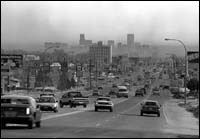
The “clean car” is cool this season. “Is your car an energy hog? Get a new one,” a web ad bombards me before I have finished the morning’s second cup of coffee. “Your vote counts here,” says the flashing ad that rates the energy efficiency of the web surfer’s car, luring owners to buy a scrubbed-up replacement.
The shock to my system from the vehicular hype notwithstanding, this environmental ruse — a green-gimmick sales pitch — is understandable from the manufacturer’s perspective. “The industry is in crisis,” says even the nightly French television news, showing an empty Chrysler lot. With automobile sales slowing, Detroit seems conflicted — Ford is going retro with a new/old Thunderbird, while General Motors is burying the Oldsmobile.
Disturbingly, however, it isn’t only the Big Three heirs or the online peddlers who are pushing us to purchase a new vehicle, through their consume to conserve come-on. It’s the greens who are buying — and buying plenty. The new hybrid Toyota Prius is backlisted with the names of enviro buyers, while eco-leaders like Amory Lovins preach that the fuel cell will solve all our transportation ills. Praise for new technology vehicles dominated even the plenary session at the fall meeting of the Society of Environmental Journalists, set two hours north of Motown, in Lansing, Mich., last fall.

Is the Prius drawing enviros to the Dark Side?
The attempt to solve our mobility and environmental problems through the same-old same-old came through especially loud and clear recently as two petitions came my way. Scarcely had the first — a plea to stop despoiling the Arctic wilderness — entered my inbox, when the second, a call for a “clean car,” popped up. “Please provide affordable clean green cars for consumers like me as soon as possible,” said the green petitioners’ message.
Why are enviros offering such fractionalized, automated, anti-environmental solutions to our mobility woes?, I wondered. Why weren’t they calling for walkable communities? or public transit? or smaller oil and auto subsidies? Instead of gathering signatures of advocates for clean-car alternatives, why weren’t green activists attacking the $58 billion federal transportation bill skewed to the automobile? Instead of obeying the Toyota Prius plea to buy because “obviously nature approves,” why weren’t they considering the automobile’s larger mistreatment of the natural world?
To be sure, in the shadow of The Hague’s climate-treaty meetings, where America derailed talks to mandate lower greenhouse gas emissions, the so-called clean car might seem palatable. Who wouldn’t prefer it to unregulated, low-mileage, dirt engines from the SUV energy hogs that crowd our roads and contribute mightily to environmental malaise?
Wake Up!
But the “clean car” alternative is a pernicious palliative from the get-go. Behind the camouflage lies this truth: One-third of the energy and resources consumed in the lifetime of each automobile are consumed in production. And the problems don’t end there.
A “clean car” does not ameliorate the damage done by our paving the planet. Clean car or no, highways and their runoff remain the primary contributor to habitat disruption and species loss. Clean car or no, sprawl consumes 1.2 million acres of farmland a year and 60,000 acres of wetland, eroding our urban and suburban cores in the process.

A breath of fresh air?
Photo: NREL/PIX.
And a low-emissions vehicle provides no answer to the problems of 55 million school-age children (and more than that number of elderly people) immobilized by a car-oriented, unwalkable world. Nor does it do anything for the 9 percent of the population, most of them minorities and women, who lack an automobile in a car-bound society that deprives them of decent public transportation. Nor, for that matter, does the clean car help the overworked Americans who log two-thirds of their auto miles for errands and shopping — a ton or two of steel-and-wheel for a gallon of milk.
In the end, buying into pseudo-clean consumption undermines any real possibility that politics and planning will solve the land use and environmental problems bred by car dependency. As the millennium begins, such planning offers us a chance to do better. New light-rail lines combined with plans for transit-oriented development have proved effective even in live-free-or-die Dallas, Amtrak use is on the rise, and the misery of traffic congestion and environmental destruction is winning daily converts to the cause.
Environmentalists must see through the faux green contrivances of the car guys and plan a truly green mobility.



